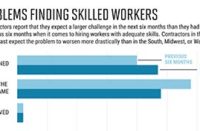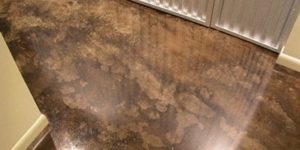 With the World of Concrete in full swing, manufacturers and distributors are showcasing lots of new gadgets, gizmos and products promising to make you more successful, more innovative, more … well, you get the picture, right? This time of year can be both exciting and stressful at the same time. We are always looking for ways to “get a leg up” on the competition — to improve, to be the best. But what does being the best even mean?
With the World of Concrete in full swing, manufacturers and distributors are showcasing lots of new gadgets, gizmos and products promising to make you more successful, more innovative, more … well, you get the picture, right? This time of year can be both exciting and stressful at the same time. We are always looking for ways to “get a leg up” on the competition — to improve, to be the best. But what does being the best even mean?
A well-positioned and executed stencil can easily add an eye-catching touch to a project.
Several years ago in the Southwest, a colleague and I were providing a “hands-on” decorative concrete training seminar which could be classified as Decorative Concrete 101. The training was extremely well attended, the participation level was high, and the questions asked and the discussions that ensued were both interesting and enlightening. In the days and weeks that immediately followed, we noticed an uptick in sales of the products demonstrated. It was a successful training on all accounts.
Oftentimes, when providing a training like this, we’ll pass out a brief survey to better understand what went well, what could be improved or what the local contractors are looking for in a future training seminar.
While an overwhelming majority came back with great feedback as to the quality of the training they received, there was a large number who asked for “advanced” training — kind of a Decorative Concrete 404. The local distributor was completely onboard with “advanced” decorative concrete training, believing it would mean an even larger increase in sales the following time around.
I must admit, we were excited to come back and provide a very exciting training seminar, a seminar where we would “pull out all the stops” and show what is truly possible with decorative concrete.
 Little things are important
Little things are important
The following year, true to our word, we returned with a great Advanced Decorative Concrete seminar. It was a seminar that — for lack of a better description — was on steroids. We literally and figuratively went “all in.” We used every type of advanced technique or process one could even begin to imagine and then some.
Again, the event was well attended. There were plenty of “oohs and ahhs” from attendees, as well as great dialogue, great insights and lots of questions.
What we realized afterwards through our normal follow-up was that while those who attended felt like they learned something, it didn’t translate to more work for them or more product sold by the distributor. It didn’t move the proverbial needle.
When we pulled the string back and investigated a little further, we discovered what we already intuitively knew: You don’t need to make a “big splash” or be “over the top” to be successful. You just need to do the little things well. In other words, be yourself — but be your best self.
Don’t try to be someone you’re not
So, what do I mean when I say, ‘be your best self’? It means just what it sounds like. Be the best version of you. Don’t try to be something or someone you’re not.
In decorative concrete terms it means providing your customers with the best finished product on every project. For example, don’t try to provide advanced decorative concreting techniques (i.e., multicolored acid-stained mosaics or European Fan stamp patterns) until you have mastered single-color staining or seamless texture skins in stamping. Remember the saying, decorative concrete done well is free advertising while decorative concrete done poorly is a black mark on the industry.
Some of the most beautiful decorative concrete I’ve ever seen isn’t, in some circles, considered decorative concrete at all because it had neither color nor stamp texture. It is simply gray concrete, done exceptionally well.
Gray concrete finished with a half-fan technique can be impressive.
Gray concrete broom-finished at right angles or broomed and picture framed with shiners can be decorative. So can gray concrete finished with a half-fan technique. Done well, it is impressive.
Surface deactivated concrete, whether colored or not, can be both aesthetically pleasing and functional in use. Some of the best stamp-work I’ve ever seen is a simple seamless slate or granite texture with saw cuts that provide symmetry and style. Nothing really advanced about it — just concrete done well.
 Pay attention to details
Pay attention to details
Part of being your best self is paying attention to a project’s details. First, as we have discussed in previous articles, is setting and then managing your client’s expectations. This is crucial to any successful project.
Second, there are logistics. I’m referring to one’s ability to handle the logistics of the project to ensure all product, supplies and tools necessary are on-site, easily accessible and accounted for.
Lastly, executing your plan and paying attention to the smallest detail on every project, whether it’s logistical in nature or actual physical detail. This is what sets you apart. This is what makes you, you.
To be clear, I’m a huge fan of advanced techniques in decorative concrete. I love intricate stamp patterns with integral color and color hardener “flashed in” for a realistic effect. I love various stains and dyes used in conjunction with each other to give depth and character. I’m pleased when decorative contractors look to grow and expand their offering by incorporating newly acquired skills.
What I am saying is: Do the things you’re good at. Continue to learn new skills and perfect them through mock-ups before you use them on a real job. Crawl before you walk and walk before you run.
To be your best doesn’t mean you have to always do the most difficult projects. It simply means you do your best work on every project.
Just be yourself … but be your best self.















